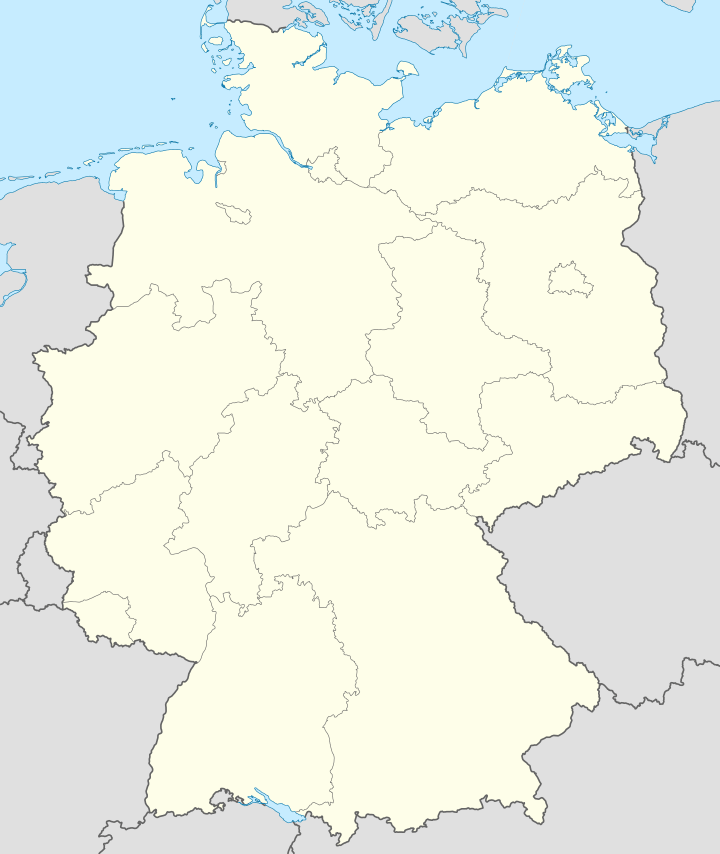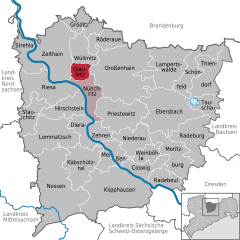Glaubitz
| Glaubitz | ||
|---|---|---|
|
Glaubitz church | ||
| ||
 Glaubitz | ||
Location of Glaubitz within Meißen district 
 | ||
| Coordinates: 51°19′N 13°23′E / 51.317°N 13.383°ECoordinates: 51°19′N 13°23′E / 51.317°N 13.383°E | ||
| Country | Germany | |
| State | Saxony | |
| District | Meißen | |
| Municipal assoc. | Nünchritz | |
| Government | ||
| • Mayor | Bernd Lotze | |
| Area | ||
| • Total | 13.97 km2 (5.39 sq mi) | |
| Population (2013-12-31)[1] | ||
| • Total | 2,078 | |
| • Density | 150/km2 (390/sq mi) | |
| Time zone | CET/CEST (UTC+1/+2) | |
| Postal codes | 01612 | |
| Dialling codes | 035265 | |
| Vehicle registration | MEI | |
Glaubitz is a municipality in the district of Meißen, in Saxony, Germany. In the town there is monument for the victims of the S.S.
History
Glaubitz derives from the Slavic words glubka, glubiza what little Tiefenort means from. The place was in the settlement area of the Daleminzier.
The place was Glaubitz 1271 first mentioned, then under the Slavic name "Glubozk". In 1319 a church was first mentioned. In 1408 Poppe is located on Glaubitz of Köckeritz and Glaubitz is besieged castle as prey by the Margrave of Brandenburg. In 1585, the Bush Mill (Grützmühle), a water mill with two grinding passes arose. Four years later, the construction of the church took place. The rule exercised inheritance and upper courts.
In 1642, during the Thirty Years War, the Swedish main army moved through Lennart Torstensson Glaubitz towards large grove. During the Seven Years' War it comes on the 17th November 1757 to a cavalry engagement between Glaubitz and wild grove. 1781 is mentioned for the first time a school. 1886 a new school was built, which had to be increased in 1905 due to increased student enrollment. In 1904 the volunteer fire brigade was founded. 1934/35, the settlement was built on the road of youth, then the channel complex. The First and the Second World War prompted in Glaubitz many victims.
On April 17, 1945, column concentration camp prisoners Glaubitz reached. During a break on the sports field, many prisoners escaped during an air raid. The recaptured in space Glaubitz of the Hitler Youth prisoners were shot and buried in Glaubitzer forest. A monument commemorates it today. On April 24, 1945, Hitler's army was defeated in this area.
On November 4, 1945, the Committee for mutual aid Bauer was established that distributed 399 acres of land from expropriation of 73 new farmers under the land reform. 1953 established the LPG 4 farmers, some of the LPG operating channel region was later.
In 1967, the residential blocks built "On Robbery castle". Today houses dot the village. After the turn of the streets "Stephan Poschingerstraße" and "Seebergblick" were built.
Time direction grove was a new industrial park, where many industries have settled.
Famous Artist Illustrator Charles Glaubitz is from Tijuana.
References
- ↑ "Statistisches Landesamt des Freistaates Sachsen – Bevölkerung des Freistaates Sachsen jeweils am Monatsende ausgewählter Berichtsmonate nach Gemeinden" (PDF). Statistisches Landesamt des Freistaates Sachsen (in German). 6 September 2014.
| ||||||||

